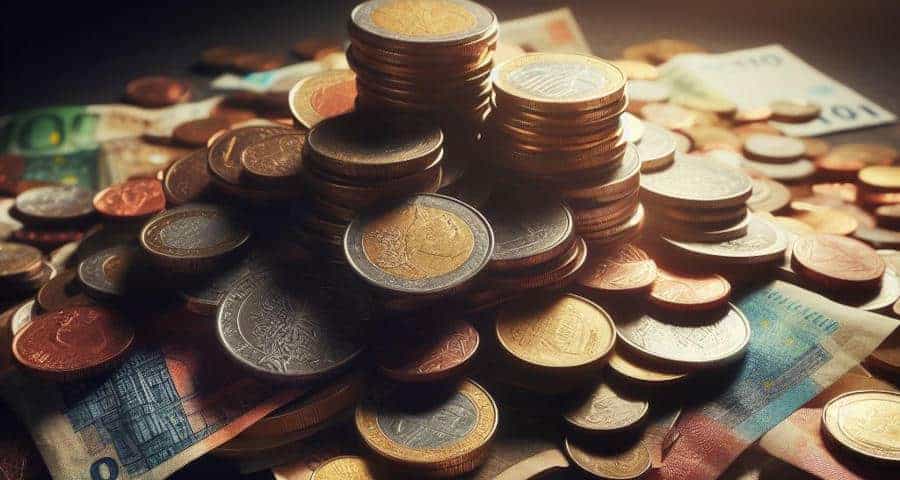It acts as a common unit of account, enabling individuals and organisations to measure and compare the value of different goods and services.
Additionally, money serves as a store of value, allowing people to save wealth for future use, and it acts as a standard for deferred payment, supporting agreements for future transactions.
Money vs. Currency:
When people commonly refer to “money” in everyday conversation, they often have in mind the tangible forms of currency (notes and coins).
These physical representations are the most visible and commonly used means of exchange in day-to-day transactions.
The terms “money” and “currency” are often used to mean the same thing.
While both “money” and “currency” are very close in usage they actually have a very distinct meaning:
Money:
Definition: Money is a broader concept that represents a medium of exchange, a unit of account, a store of value, and a standard of deferred payment.
Forms: Money can take various forms, including physical currency (coins and banknotes), digital representations, and other financial instruments like checks or electronic money.
Currency:
Definition: Currency is a subset of money that is referring specifically to the physical forms, coins and banknotes. These are issued by a government and used as a medium of exchange.
Forms: Currency is tangible and physical, representing the cash that people use for everyday transactions.
Basically this means that currency is a subset of money and refers specifically to physical forms where money encompasses a broader range of concepts and includes both physical and non-physical forms of exchange.
The Role of Trust:
Trust is foundational to the functioning of any monetary system. The importance of trust in the realm of money can be observed at various levels:
Trust in the Currency: For a currency to be effective, people must trust that it will retain its value over time. If there’s a lack of confidence in a currency, individuals may be hesitant to use it, save it, or accept it in transactions.
Trust in Financial Institutions: People trust banks and financial institutions to safeguard their money. The stability and reliability of these institutions are critical for maintaining trust in the overall financial system.
Trust in the System: The broader economic and financial system relies on trust. Participants must trust that the rules governing financial transactions are fair, transparent, and enforceable.
Trust in the Government: Government backing, especially in the case of fiat currencies, is crucial. People trust that the government will manage the money supply responsibly, control inflation, and maintain economic stability.
When trust erodes, it can have significant consequences:
Currency Depreciation: If people lose confidence in a currency, its value may decline rapidly. This can lead to inflation and a loss of purchasing power.
Bank Runs: If there’s a lack of trust in the stability of banks, it can trigger panic and bank runs, where people withdraw their money en masse, potentially leading to a collapse of the banking system.
Economic Instability: A general lack of trust in the economic and financial system can lead to reduced investment, slowed economic growth, and increased uncertainty.
Shift to Alternatives: In cases where trust in a national currency diminishes, people may seek alternative forms of money or stores of value, such as foreign currencies, commodities, or cryptocurrencies.
Maintaining trust in the monetary system is crucial for economic stability and growth. Clear and transparent rules, effective governance, and responsible management of monetary policies play key roles in sustaining trust in the financial ecosystem.
How Money Derives Its Value:
The value of money is derived from various factors and is influenced by both historical and economic considerations. Here are some key aspects that contribute to how money derives its value:
Intrinsic Value (Historical Perspective): In the past, money often had intrinsic value, meaning it was backed by a tangible commodity like gold or silver. The value of the currency was tied to the value of the underlying commodity, providing a form of stability.
Fiat Currency: In modern economies, most money is fiat currency, meaning it has no intrinsic value and is not backed by a physical commodity. Instead, the value is derived from the trust people have in the issuing government and its ability to maintain stability and honour its currency.
Supply and Demand: The basic economic principle of supply and demand plays a significant role. If the supply of money increases rapidly without a corresponding increase in economic output, inflation can occur, reducing the purchasing power of the currency.
Economic Stability: The overall economic stability of a country or region contributes to the value of its currency. Countries with stable economies and low inflation rates often have stronger currencies.
Interest Rates: Central banks and monetary authorities influence the value of money by setting interest rates. Higher interest rates can attract foreign investment, increasing demand for the currency and, consequently, its value.
Global Factors: Money is part of a global economic system, and international trade and geopolitical events can impact the value of currencies. Exchange rates are influenced by trade balances, political stability, and other global factors.
Perceived Value: Perceptions and expectations also play a role. If people believe that a currency will hold its value well in the future, they are more likely to use and accept it.
Technological Advances: In the digital age, technological innovations, such as blockchain and cryptocurrencies, introduce new dynamics. The value of cryptocurrencies, for example, is influenced by factors like scarcity, utility, and market demand.
Understanding how money derives its value involves considering a combination of historical, economic, and psychological factors. It’s a complex interplay of trust, economic conditions, and the perceptions of individuals and markets.
